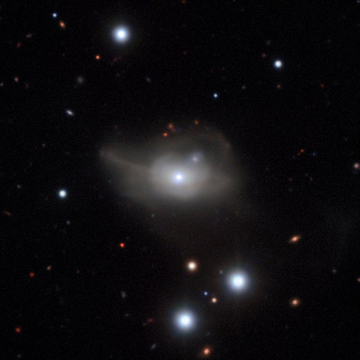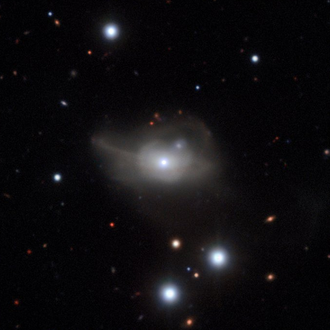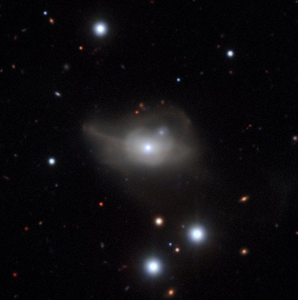Starving Black Hole Returns Brilliant Galaxy to the Shadows
The mystery of a rare change in the behaviour of a supermassive black hole at the centre of a distant galaxy has been solved by an international team of astronomers using ESO’s Very Large Telescope along with the NASA/ESA Hubble Space Telescope and NASA’s Chandra X-ray Observatory. It seems that the black hole has fallen on hard times and is no longer being fed enough fuel to make its surroundings shine.
Many galaxies are found to have an extremely bright core powered by a supermassive black hole. These cores are thought to shine so brightly due to hot material glowing fiercely as it falls into the black hole, a process known as accretion.
Some of these galaxies with active nuclei have been observed to change dramatically over the course of only 10 years; a blink of an eye in astronomical terms. However, the active galaxy in this new study, Markarian 1018 (Mrk 1018), stands out by having changed type a second time, reverting back to its initial classification within the last five years. Only a handful of galaxies have already been observed to make this full-cycle change, but never before has one been studied in such detail.
The discovery of Mrk 1018’s fickle nature was a lucky chance by-product of the Close AGN Reference Survey (CARS) with the Multi-Unit Spectroscopic Explorer (MUSE) installed at ESO’s Very Large Telescope.
Tanya Urrutia, scientist at the Leibniz Institute for Astrophysics Potsdam (AIP), stated: "MUSE's unprecedented 3-dimensional capabilities and its large field of view are unique to disentangle various physical processes in these growing black holes. With our CARS survey, we are now able to distinguish the impact of a quasar on its host galaxy visually."
The chance observation of the galaxy so soon after it began to fade is an unexpected opportunity to learn what makes these galaxies tick, as Bernd Husemann, CARS project leader and lead author of one of two papers associated with the discovery, commented: “We were lucky that we detected the event just 3-4 years after the decline started so we could begin monitoring campaigns to study details of the accretion physics of active galactic nuclei that cannot be studied otherwise.”
The team was able to gather extra data after they were awarded observing time using the NASA/ESA Hubble Space Telescope, and NASA’s Chandra X-ray Observatory. Using the new data from this suite of instruments, they solved the mystery, finding that the black hole was slowly fading as it became starved of accretion material. Co-author and AIP astrophysicist Mirko Krumpe explained: "A number of astrophysical events could have been caused the dimming. We were able to rule out tidal disruption events and cast doubt on the possibility of obscuration by intervening gas."
Rebecca McElroy, lead author of the discovery paper and PhD student at the University of Sydney and the ARC Centre of Excellence for All Sky Astrophysics (CAASTRO), stated: “An intriguing possibility is that this could be due to interactions with a second supermassive black hole.” This hypothetical black hole binary system is a distinct possibility in Mrk 1018, as the galaxy is the product of a major merger of two galaxies — each of which likely contained a supermassive black hole in its centre.
Scientific publication:
“Mrk 1018’s return to the shadows after 30 years as a Seyfert 1” and “What is causing Mrk 1018’s return to the shadows after 30 years?”, both to appear in the journal Astronomy & Astrophysics.
Science contact:
Dr. Tanya Urrutia, turrutia@aip.de, +49 331-7499-664
Dr. Mirko Krumpe, mkrumpe@aip.de, +49 331-7499-334
Media contact:
Kerstin Mork, presse@aip.de, +49 331-7499 803
The mystery of a rare change in the behaviour of a supermassive black hole at the centre of a distant galaxy has been solved by an international team of astronomers using ESO’s Very Large Telescope along with the NASA/ESA Hubble Space Telescope and NASA’s Chandra X-ray Observatory. It seems that the black hole has fallen on hard times and is no longer being fed enough fuel to make its surroundings shine.
Many galaxies are found to have an extremely bright core powered by a supermassive black hole. These cores are thought to shine so brightly due to hot material glowing fiercely as it falls into the black hole, a process known as accretion.
Some of these galaxies with active nuclei have been observed to change dramatically over the course of only 10 years; a blink of an eye in astronomical terms. However, the active galaxy in this new study, Markarian 1018 (Mrk 1018), stands out by having changed type a second time, reverting back to its initial classification within the last five years. Only a handful of galaxies have already been observed to make this full-cycle change, but never before has one been studied in such detail.
The discovery of Mrk 1018’s fickle nature was a lucky chance by-product of the Close AGN Reference Survey (CARS) with the Multi-Unit Spectroscopic Explorer (MUSE) installed at ESO’s Very Large Telescope.
Tanya Urrutia, scientist at the Leibniz Institute for Astrophysics Potsdam (AIP), stated: "MUSE's unprecedented 3-dimensional capabilities and its large field of view are unique to disentangle various physical processes in these growing black holes. With our CARS survey, we are now able to distinguish the impact of a quasar on its host galaxy visually."
The chance observation of the galaxy so soon after it began to fade is an unexpected opportunity to learn what makes these galaxies tick, as Bernd Husemann, CARS project leader and lead author of one of two papers associated with the discovery, commented: “We were lucky that we detected the event just 3-4 years after the decline started so we could begin monitoring campaigns to study details of the accretion physics of active galactic nuclei that cannot be studied otherwise.”
The team was able to gather extra data after they were awarded observing time using the NASA/ESA Hubble Space Telescope, and NASA’s Chandra X-ray Observatory. Using the new data from this suite of instruments, they solved the mystery, finding that the black hole was slowly fading as it became starved of accretion material. Co-author and AIP astrophysicist Mirko Krumpe explained: "A number of astrophysical events could have been caused the dimming. We were able to rule out tidal disruption events and cast doubt on the possibility of obscuration by intervening gas."
Rebecca McElroy, lead author of the discovery paper and PhD student at the University of Sydney and the ARC Centre of Excellence for All Sky Astrophysics (CAASTRO), stated: “An intriguing possibility is that this could be due to interactions with a second supermassive black hole.” This hypothetical black hole binary system is a distinct possibility in Mrk 1018, as the galaxy is the product of a major merger of two galaxies — each of which likely contained a supermassive black hole in its centre.
Scientific publication:
“Mrk 1018’s return to the shadows after 30 years as a Seyfert 1” and “What is causing Mrk 1018’s return to the shadows after 30 years?”, both to appear in the journal Astronomy & Astrophysics.
Science contact:
Dr. Tanya Urrutia, turrutia@aip.de, +49 331-7499-664
Dr. Mirko Krumpe, mkrumpe@aip.de, +49 331-7499-334
Media contact:
Kerstin Mork, presse@aip.de, +49 331-7499 803





